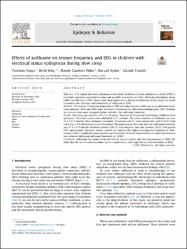| dc.contributor.author | Topçu, Yasemin | |
| dc.contributor.author | Kılıç, Betül | |
| dc.contributor.author | Gazeteci Tekin, Hande | |
| dc.contributor.author | Aydın, Kürşad | |
| dc.contributor.author | Turanlı, Güzide | |
| dc.date.accessioned | 2021-02-12T06:28:10Z | |
| dc.date.available | 2021-02-12T06:28:10Z | |
| dc.date.issued | 2021 | en_US |
| dc.identifier.citation | Topçu, Y., Kılıç, B., Gazeteci Tekin, H., Aydın, K. ve Turanlı, G. (2021). Effects of sulthiame on seizure frequency and EEG in children with electrical status epilepticus during slow sleep. Epilepsy and Behavior, 116. https://dx.doi.org/10.1016/j.yebeh.2021.107793 | en_US |
| dc.identifier.issn | 1525-5050 | |
| dc.identifier.issn | 1525-5069 | |
| dc.identifier.uri | https://dx.doi.org/10.1016/j.yebeh.2021.107793 | |
| dc.identifier.uri | https://hdl.handle.net/20.500.12511/6553 | |
| dc.description.abstract | Objective: It is argued that early and adequate treatment of electrical status epilepticus in sleep (ESES) is essential to preserve cognitive functions and possibly recovering lost skills. Although antiepileptic drugs (AEDs) are effective in ESES, there is not much experience in the use of sulthiame. In this study, we aimed to examine the efficiency and tolerability of sulthiame in ESES. Methods: The data of 39 patients diagnosed as ESES and who received sulthiame as an additional treatment between 2016 and 2020 were reviewed retrospectively. Electroencephalographic (EEG) findings and seizure rates were compared before and after the sulthiame treatment. Results: The mean age was 8.5 ± 4.1 (1.5–16 years). Nine out of 39 patients had benign childhood focal epilepsies. Structural causes were identified in 13 patients. The mean duration of sulthiame use was 32.5 ± 13.7 months. After sulthiame treatment, 25 patients (64.1%) were seizure free, and 8 (20.5%) had more than a 50% decrease in seizure frequency. The mean seizure-free time after the sulthiame treatment was 27.8 ± 17.9 months. Nineteen patients (48.7%) had complete, and nine patients (23.1%) had partial EEG improvement. Complete seizure control was significantly higher in benign focal epilepsy of childhood (p = 0.01). Significant neurocognitive and behavioral recovery, improvement in school performance was observed following sulthiame treatment (p < 0.001). Conclusion: Sulthiame was found to be effective in seizure control and EEG improvement in ESES. We think that the use of sulthiame alone can be a good choice with high efficacy and tolerability in ESES. | en_US |
| dc.language.iso | eng | en_US |
| dc.publisher | Academic Press Inc. | en_US |
| dc.rights | info:eu-repo/semantics/embargoedAccess | en_US |
| dc.subject | Sulthiame | en_US |
| dc.subject | Electrical Status Epilepticus During Slow Sleep | en_US |
| dc.subject | EEG | en_US |
| dc.subject | Seizure | en_US |
| dc.subject | Children | en_US |
| dc.title | Effects of sulthiame on seizure frequency and EEG in children with electrical status epilepticus during slow sleep | en_US |
| dc.type | article | en_US |
| dc.relation.ispartof | Epilepsy and Behavior | en_US |
| dc.department | İstanbul Medipol Üniversitesi, Tıp Fakültesi, Dahili Tıp Bilimleri Bölümü, Çocuk Sağlığı ve Hastalıkları Ana Bilim Dalı | en_US |
| dc.authorid | 0000-0003-1513-6149 | en_US |
| dc.identifier.volume | 116 | en_US |
| dc.relation.publicationcategory | Makale - Uluslararası Hakemli Dergi - Kurum Öğretim Elemanı | en_US |
| dc.identifier.doi | 10.1016/j.yebeh.2021.107793 | en_US |
| dc.identifier.wosquality | Q2 | en_US |
| dc.identifier.scopusquality | Q2 | en_US |


















